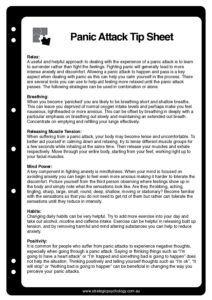
Panic Attack Tip Sheet
58 KB
A panic attack is a feeling of an overwhelming sense of sudden fear and anxiety. Almost all conditions of anxiety can have panic attacks in their presentation. However these attacks most commonly affect those who suffer from panic disorder. A common sign or symptom of Panic Disorder occurs when a person experiences repeated panic attacks.
Often those who experience panic attacks will also experience significant anticipatory anxiety , which can bring on additional panic attacks. This can lead to a vicious cycle of anxiety and panic attacks.
Panic attacks can occur randomly and without warning. However they often occur in similar places to those where panic attacks have previously been experienced. In general panic attacks only last minutes but to those experiencing them they can feel endless. Often after experiencing a panic attack a person will feel physically exhausted from the emotional effects of a panic attack.
Panic attacks begin with an intrusive fear, apprehension or terror and are then accompanied by physical symptoms which include:
Increased heart rate
Dizziness
Faintness
Sensations of choking or being smothered
Chest pain
Trembling
Feeling detached from surroundings
Sweating
Nausea
Numbness
Hot or cold flashes
Feeling of loss of control
Those who suffer from panic attacks can also experience a condition called agoraphobia. Agoraphobia is the fear of leaving one’s home or entering public or wide open spaces that could potentially be hard for them to escape from, be embarrassing or cause some sort of distress. Due to the fact that sufferers of panic attacks often avoid leaving their home due to the fear that a panic attack could happen while they are in a public place, they therefore have a greater potential to develop agoraphobia in conjunction. Though this may happen it does not happen to all sufferers of panic attacks or panic disorder. Those who suffer from agoraphobia may be able to leave their home, it is usually done reluctantly and almost always with a high level of anxiety.
Treatment
The treatment method that is most commonly used for treating panic disorder or panic attacks is Cognitive Behavioural Therapy (CBT) or Acceptance and Commitment Therapy (ACT) in combination with graded exposure. This treatment method aims to show sufferers that their fears or that the panic attacks that they may suffer do not really have such terrifying consequences as they may think. By systematically desensitising sufferers to their panic attacks and showing their fears in a different light, the anxiety that they may feel can start to be reduced and in turn the fear of another panic attack can also be reduced.
Click here to print a copy of the Panic Attacks Tip Sheet.
